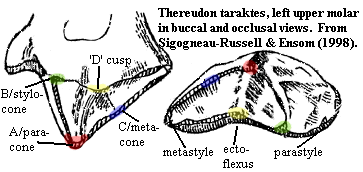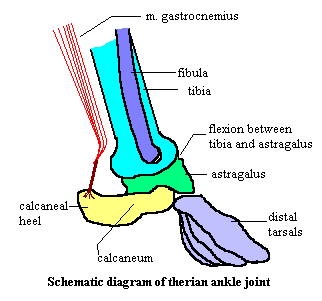 Spalacotheroidea:
Spalacotheroidea:| Mammalia | ||
| The Vertebrates | Spalacotheroidea |
| Vertebrates Home | Vertebrate | Vertebrate |
Abbreviated Dendrogram
Mammaliformes
│
└─Mammalia
├─Australosphenida
│ ├─Ausktribosphenidae
│ └─Monotremata
└─┬─Triconodonta
└─┬─Spalacotheroidea
│ └─┬─Tinodontidae
│ └─┬─Thereudontidae
│ └─┬─Spalacotheriidae
│ └─Barbereniidae
└─Cladotheria
├─Dryolestoidea
└─Theria
│
├─Metatheria
└─Eutheria |
Contents
Overview |
Range: upT-upK of NAm, SAm, China & Eur.
Phylogeny: Mammalia::: Cladotheria + *: Tinodontidae + (Thereudontidae + (Spalacotheriidae + Barbereniidae)).
Links: Spalacotheroidea.
References: Hu et al. (1997) [H+97]; Luo et al. (2001a) (for phylogenetic position). APW 040806
Tinodontidae: Bondesius, Cyrtlatherium, Gobitheriodon, Mictodon, Tinodon. Traditionally, the "obtuse-angle symmetrodonts"
Range: Late Triassic to Late Cretaceous of North America & Europe (mostly European)
Phylogeny: Spalacotheroidea: Thereudontidae + (Spalacotheriidae + Barbereniidae)) + *.
Characters: pterygoid fossa small & triangular [A02]; upper molars: A/paracone highest cusp [F85]; parastyle abuts metastyle of adjacent molar; preparacrista links A/paracone with B/stylocone [F85]; preparacrista more transverse and shorter than postparacrista, which links A/paracone with C/metacone (or 'c' cusp) [F85 -- but see note 1]; trigon angle decreases from ~160° mesially to ~100° distally [F85]; cingulum without cusps [F85]; cingulum complete buccally & incomplete lingually [F85]; 3 lower premolars & 4 lower molars [A02]; lower molars: highly compressed trigonid (very acute angle) [ES00]; a/protoconid largest and most labial; small talonid present which may bear a small d/"hypoconulid?" [F85 -- see note 2]; distal protocristid, linking a/protoconid and c/metaconid more transverse and shorter than mesial paracristid linking a/protoconid and b/paraconid [F85]; trigonid angle decreases from ~160° mesially to ~90° distally [F85] (contra [A02]: actually increases between m2 & m3); mesiobuccal cingulid short or absent, particularly on distal molars [F85].
Notes: [1] Fox [F85] treats the 'c' cusp as if it were synonymous with the C/metacone. This seems contrary to the usage of, e.g., [SE98], who not only treat them as separa ies, but identify both a "metacone" and a "'c' cusp" on the same teeth in Microderson laaroussii and Thereudon dahmani. A plague on all of them! It would seem far better practice to reserve any use of lower case cusp designations for lower molars in order to avoid confusion with the c/metaconid. [2] It is at this point that Fox's nomenclature appears to fall apart, as discussed elsewhere. I have substituted the terms which I think he intended, which may do more harm than good. To be as clear as possible in this murky area, the large, buccal, central cusp on the lower molars will be referred to as "a/protoconid." The more distal of the two smaller, lingual cusps will be referred to as the "c/metaconid," and the more mesial as the "b/paraconid." [3] Just to confuse things more, Fox [F85] envisions Tinodontidae as including (only?) Tinodon, Cyrtlatherium and Kuehneotherium, which confounds the tinodonts with the kuehneotheriids. Were it not for the very genuine awe which his work on squamates and choristoderes inspires, one might be tempted to apply one's own metacarpal-phalangeal joints so as to manually rearrange Prof. Fox's own, personal, dentition. ATW011222.
Links: Mesozoic Mammals; Spalacotheriidae, Tinodontidae and other derived symmetrodonts, an internet directory (Best on the Web); Slide 43; Bat and butterfly wars (stating that Bondesius was a bat,); Cifelli & Madsen.
References: Averianov 2002) [A02]; Ensom & Sigogneau-Russell (2000) [ES00]; Fox (1985) [F85]; Sigogneau-Russell & Ensom (1998) [SE98]. APW 040806.
 Thereudontidae: Thereudon
Thereudontidae: Thereudon
Range: lwK of England & NAfr.
Phylogeny: Spalacotheroidea:: Spalacotheriidae + Barbereniidae) + *.
Characters: upper molars transversely narrow, with 3 basins [SE98]; upper molars with 2-3 roots [SE98]; trigon angle acute [SE98]; A/paracone tall [SE98]; large parastylar lobe almost forming a basin [SE98]; vertical concavity on mesial face of the A/paracone [SE98]; A/paracone recurved buccally [SE98]; well-developed B/stylocone [SE98]; presence of a central, buccal 'D' cusp as large as the B/stylocone [SE98]; "mediocrista" crista linking A/paracone to buccal cingulum near 'D' cusp [SE98]; C/metacone may be paired with a 'c' conule on postparacrista [SE98]; wear facets on mesial face of paracone (strong) and on distal face (weak) [SE98];
References: Sigogneau-Russel & Ensom (1998) [SE98].
Note: a group possibly straddling the Gondwanan-Laurasian divide. This could have significance for the Austrosphenidan-Ausktribosphenidan controversy, i.e. for the isues of whether tribosphenic mammals are monophyletic and whether the ausktribosphenids are Gondwanan placentals or monotreme sisters. Interestingly, [SE98] state that the English form may be more basal than the African.
APW 040806.
Spalacotheriidae: Peralestes (upper dentition of Spalacotherium), Spalacotheridium, Spalacotherium, Symmetrodontoides, Zhangheotherium.
mJ-upK of Eur, China & NAm (mostly Laurasian). "Acute-angle" symmetrodonts.
Spalacotheroidea::: Barbereniidae + *.
cranial: squamosal with long glenoid and post-glenoid crest [H+97]; squamosal with constricted neck posterior to glenoid, then broadens to form wall of epitympanic recess [H+97]; part of constriction (outer surface) is post-glenoid depression possibly reflecting an external auditory meatus [H+97]; cochlea probably uncoiled [H+97]; dentary with dorsally curved condylar process & posteriorly tilted coronoid process [H+97]; mandipular symphysis oval, unfused, probably mobile [H+97]; Meckelian groove narrow & is shallow and faint anteriorly [H+97]; small splenial and/or coronoid may have been present [H+97]; upper molars: upper molars essentially trituburcular [F85]; upper molars with 2 roots [F85]; upper molars angle formed by three principal cones is < 90° on M1 and becomes more acute on more distal molars [F85]; upper molars with median crest (?); B/stylocone reduced [F85]; cones more symmetrical than in kuehneotheriids [F85]; molars broad; parastyle hooks mesiobuccally to contact metastyle of next anterior molar [F85]; frequent development of a 'D' stylar cusp on the buccal cingulum [SE98]; lower molars: talonid very small or absent [H+97]; trigonid well-developed [F85]; trigonid angle usually < 90° [F85] [H+97]; paracristid and protocristid more nearly equal in length [F85]; basal cingulid complete lingually (except Zhangeotherium [H+97]), but may be incomplete buccally [F85]; axial: vertebrae 7/13/6/4/? [H+97]; cervical ribs not fused to vertebrae [H+97]; thoracic ribs robust and anteroposteriorly compressed [H+97]; appendicular: small, V-shaped interclavicle overlaps manubrium ventrally and articulates with it [H+97]; interclavicle with loose, mobile connection to clavicles [H+97]; clavicles with spiral articulation with acromion process (also somewhat mobile) [H+97]; glenoid faces ventrally [H+97]; supraspinousfossa well-developed but narrow, with prominent acromion process [H+97]; coracoid process hook-like [H+97]; mobile articulations allow clavicle as pivotal strut for wide rotation of scapula as in opossum [H+97]; humerus robust, with long deltopectoral crest [H+97]; humeral tortion about 30° [H+97]; humerus with "incipient trochlea" for ulna (therian type) [H+97]; also weak ulnar condyle [H+97]; prominent, spherical radial condyle (primitive) [H+97]; 9 carpals with very large pisiform [H+97]; ilium long, slender and 3x as long as ischium [H+97]; shallow pelvis (unlike multis) [H+97]; femur with well-developed neck and dorsally-directed greater trochanter [H+97]; calcaneum with elongate tubercle [H+97]; external ankle spur as in monotremes [H+97].
Links:Cifelli & Madsen; Spalacotheroidea; chinois.pdf pdf file of Hu et al. (1997)); Terrestrial trans-Tethyan dispersals: An overview;
References: Fox 1985) [F85]; Hu et al. (1997) [H+97]; Sigogneau-Russell & Ensom (1998) [SE98].
Notes: [1] [H+97] emphasize that the unique adaptation of spalacotheriids, including Zhangheotherium, is the ability of the narrow trigons to occlude between the trigonids of the opposing lowers. [2] Except for dental characters, all characters are simply descriptive of Zhangheotherium, the only spalacotheriid for which we have significant non-dental remains. Accordingly, it is unknown whether these characters have any generality within the taxon. [3] Hu et al. (1997) assert that the shoulder girdle shows an intermediate condition between the sprawling posture of mammaliforms and the parasagittal posture of therians. APW 040806.
Barbereniidae: Barberenia, Bondalestes, Guirogatherium. Very late, SouthAmerican symmetrodonts.
Range: upK of SAm.
Phylogeny: Spalacotheroidea::: Spalacotheriidae + *.
Characters: insectivores.
Note: existence of this group rather dubious, even for a symmetrodont group. Bonaparte originally erected the family for 4 South American symmetrodonts, then later removed 3 of the 4 genera. Only Bondalestes is supposed to remain. Because of the uncertainty of what goes in this box, no attempt is made to characterize it.
APW 040806
Cladotheria: an awkward group combining (LCA?) Dryolestidae, Paurodontidae, Amphitheriidae, Peramuridae, and Tribosphenida. Probably not used correctly here.
from the Middle Jurassic.
Mammalia::: Spalacotheroidea + *: Dryolestoidea + Theria.
Characters: $? promontorium oval-shaped and bulbous [L+01]; $? cochlear canal at least partially coiled {L+01]; $ angular process of the dentary well-developed and posteriorly positioned [L+01]; $? last premolar a/protoconid asymmetrical [L+01]; $ b/paraconid shorter than c/metaconid [L+01]; $ talonid with at least one cusp [L+01]; $ hypoconulid positioned distal and median [L+01]; $? mesiolingual cuspule 'e' (parastylid?) absent [L+01]; $ distal lingual cingulid absent [L+01]; $? manubrium reduced [L+01]; $ interclavicle absent [L+01]; $? scapula with supraspinous fossa developed $ present along entire border of scapula [L+01]; $? humerus with deltopectoral crest not reaching mid-point shaft [L+01]; $ radius styloid process present & well developed [L+01]; $ tibial malleolus distinctive (suggests a parasagittal gait) [L+01]; $ fibular styloid process distinctive [L+01]; $? fibula with calcaneum contact reduced [L+01]; $? astragalus proximal to calcaneum [L+01]; $? astragalus with neck and (tibial?) trochlea [L+01].
Links: Cladotheria after Luo, Cifelli, & Kielan-Jaworowska, 2001; Cladotheria after McKenna & Bell, 1997; MESOZOIC MAMMALS; 'basal' Cladtheria and Peramuridae, an internet directory; Cladotheria after Wang, Clemens, Hu & Li, 1998.
References: Luo et al. (2001a) [L+01]. APW 040806.
Dryolestoidea = or > "Eupantotheria"): Aegialodon, Peligrotherium.
mJ-lwPc.
Cladotheria: Theria + *.
paraphyletic group including therian ancestor? Molars with heel but not true talonid; protocone expansion of upper molars.
Links:Untitled Italian); SistEspEvol Portuguese); Cladotheria after Luo, Cifelli, & Kielan-Jaworowska, 2001; g01n3a4.pdf. APW 040806.
 Theria: Deltatherium, Kielantherium. LCA wallabies and Wallace.
Theria: Deltatherium, Kielantherium. LCA wallabies and Wallace.
Fr mK.
Cladotheria: Dryolestoidea + *: Metatheria + Eutheria.
No quadrate-articular jaw articulation; all post-dentary bones incorporated into middle ear; tribosphenic molar; jaw opened by digastric muscle (ennervated by Vth & VIIth nerves); $ facial muscles (derived from neck constrictor colli, VIIth nerve); $ spiral cochlea; auditory pinna (external ear); $ able to seal pharynx with tongue and/or epiglottis (for suckling, swallowing by mouthfuls); scapula with supraspinous fossa; loss or fusion of coracoid elements; scapulae move independently around its dorsal border, held in place only by muscles and soft tissues of "scapular sling"; $ supracoracoideus (humeral protractor) reorganized as infraspinatus and supraspinatus which stabilize humerus; $ crurotarsal ankle joint with flexion between tibia and astragalus, astragalus proximal to calcaneum, and gastrocnemius inserting on calcaneal heel; $ mammary glands with nipples (derived from apocrine or sebaceous glands); $ viviparity, with no egg shell; separate anal & urogenital openings; skin with free nerve endings (pain receptor?), Pacinian corpuscles, growing hair, sebaceous, apocrine (and eccrine glands in some specialized forms), and numerous neuroreceptors for touch, temperature, stretch, etc.
Links: MAMMALS TROUGHOUT TIME; Mammalogy Image Archives; Introduction to Lactation Biology; Paleocene mammals of the world; Foto-album: Theria; The Systematic Relationships of the Monotremata: The Ontogenetic Evidence; Kangaroo, platypus are not related after all; News in Science 3/07/01 Debate over platypus and kangaroo link.
Note: According to Pough et al (1999), facial expressions reflect similar emotions in all species who have the requisite muscles, with exception of the human smile. APW 040806.
checked ATW050812